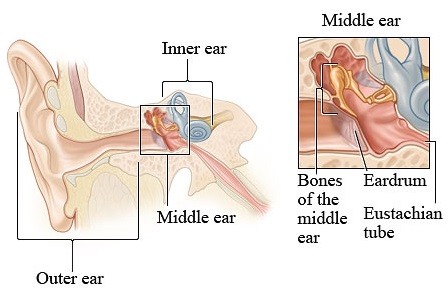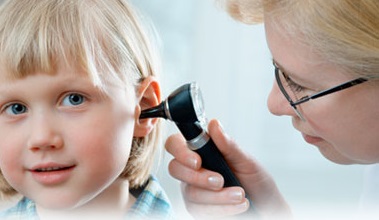 The eustachian tube refers to the tube that connects the back of the nose with the middle ear. The middle ear requires a fresh supply of air that allows sound to travel through to the ear drum. The eustachian tube opens when we chew, swallow or yawn, allowing this fresh air to flow into the ear and the stale air in the ear to flow out.
The eustachian tube refers to the tube that connects the back of the nose with the middle ear. The middle ear requires a fresh supply of air that allows sound to travel through to the ear drum. The eustachian tube opens when we chew, swallow or yawn, allowing this fresh air to flow into the ear and the stale air in the ear to flow out.
The eustachian tube is approximately 3-4cm long and provides a way for the body to drain the ear as necessary. In addition to providing a fresh supply of air to the middle ear, the eustachian tube allows mucus from the middle ear to drain. This allows the body to maintain equal pressure on both sides of the eardrum so that sound will vibrate properly and can be transferred to the brain.
What Is Eustachian Tube Dysfunction?
If the eustachian tube becomes blocked or does not open when it should the air pressure in the ear can build up, pushing on the eardrum. This means the eardrum will not vibrate the way it should, disrupting your ability to hear properly, causing the dysfunction of the eustachian tube.
What Are the Eustachian Tube Dysfunction Symptoms?
If the eustachian tube is not functioning properly, you will typically notices that your hearing appears to be muffled or dull. If the eardrum is stretched by this added pressure it can cause the ear to feel tender or tense. You may also note dizziness, a feeling as though your ear is full of liquid or ringing in the ear. This can be accompanied by a popping noise in the ear. Its symptoms are typically accompanied by the symptoms of common cold. These symptoms can last for as little as a few hours or for several weeks. In most cases these side effects are eliminated after a week. Symptoms may dull temporarily and then return at their original severity.
What Causes Eustachian Tube Dysfunction?
A number of conditions can play a role in the appearing of eustachian tube dysfunction symptoms. A blockage in the eustachian tube is a common side effect of the common cold or an infection in the ear that has led to the tissue becoming swollen. This infection can be mild, but it can also be more severe, leading to a sharp pain in the ear. Treatment is necessary to kill off this infection or hearing loss may develop.
Additional conditions that can cause eustachian tube dysfunction include:
- Allergies- Allergies that cause the nose to produce more mucus can lead to additional inflammation throughout the sinus system, including the eustachian tube. Hay fever and perennial rhinitis are commonly known for causing this discomfort. As additional mucus is produced in the nose it can drain down the eustachian tube, causing it to become plugged or feel full.
- Glue Ear- Glue ear is a condition that causes the middle ear to become filled with sticky, glue like fluid. As this substance leaks into the eustachian tube, it can become stuck, causing the eustachian tube to plug and blocking the flow of air into the ear. This can cause the ear drum to tighten, limiting your ability to hear properly. If this substance becomes stuck to the ear drum as well, it will worsen these symptoms.
- Blockages- If something such as an enlarged adenoid is pushing up against the eustachian tube it can cause the canal to become blocked. In some cases, tumors in the back of the nose can cause this blockage, which will require immediate medical attention.
- Smoke- People who smoke or are regularly exposed to smoke are much more likely to develop eustachian tube dysfunction symptoms. Smoking damages the cilia in the ear which will limit your body's ability to properly drain the middle ear through the eustachian tube.
- Altitude Changes- Moving quickly to a different altitude can cause the eustachian tube to feel restricted. Air travel, diving, snorkeling, or fast-paced elevators can contribute to this condition. If you are experiencing cold or allergy symptoms when you perform these activities it can worsen your condition.
Treatments for Eustachian Tube Dysfunction
In most cases, you will treat the side effects of ETD rather than addressing the condition head on.
Home Remedies - If the effects of ETD are mild and last less than a week you can usually treat them at home.
- Leave it Alone- If you are experiencing a cold, change in altitude or other condition that is putting pressure on the ears, you can ignore your symptoms of ETD. Blockages in the ear will typically resolve themselves in less than a week, especially if you are making a point to treat the underlying symptoms.
- Swallow and Chew- Drinking, yawning, chewing or swallowing can cause the eustachian tube to open and close, allowing it to better drain whatever substance appears to be stuck here or in the middle ear.
- Self-Inflation-Taking a deep breath, then holding the mouth and nose closed can help force air into the eustachian tube, ridding yourself of a blockage. You should hear a popping noise and then feel the pressure release if this was successful. However, forcing this activity can cause damage to the ear drum, so perform this activity with care.
- For Air Plane Ears-Children can often suck on a bottle, juice box or pacifier to help relieve their ears. Avoid flying when congested or suffering from a cold because this makes the discomfort significantly more likely.
Medical treatment can be administered if eustachian tube dysfunction symptoms are painful or will not dissipate after a few days.
- Medications- Often, medication is used to treat the congestion and inflammation around the ear. This should release the pressure on the eustachian tube. Decongestants or nasal corticosteroids can be administered to help reduce swelling or mucus. Antibiotics will also be administered if an infection is plaguing the ear.
- Surgery-In severe cases it will be necessary to surgically correct ETD. Pressure equalization tubes can be installed to help keep the eustachian tube open. You can also have a myringotomy, or a slit cut in the middle ear that will help liquid escape temporarily.
